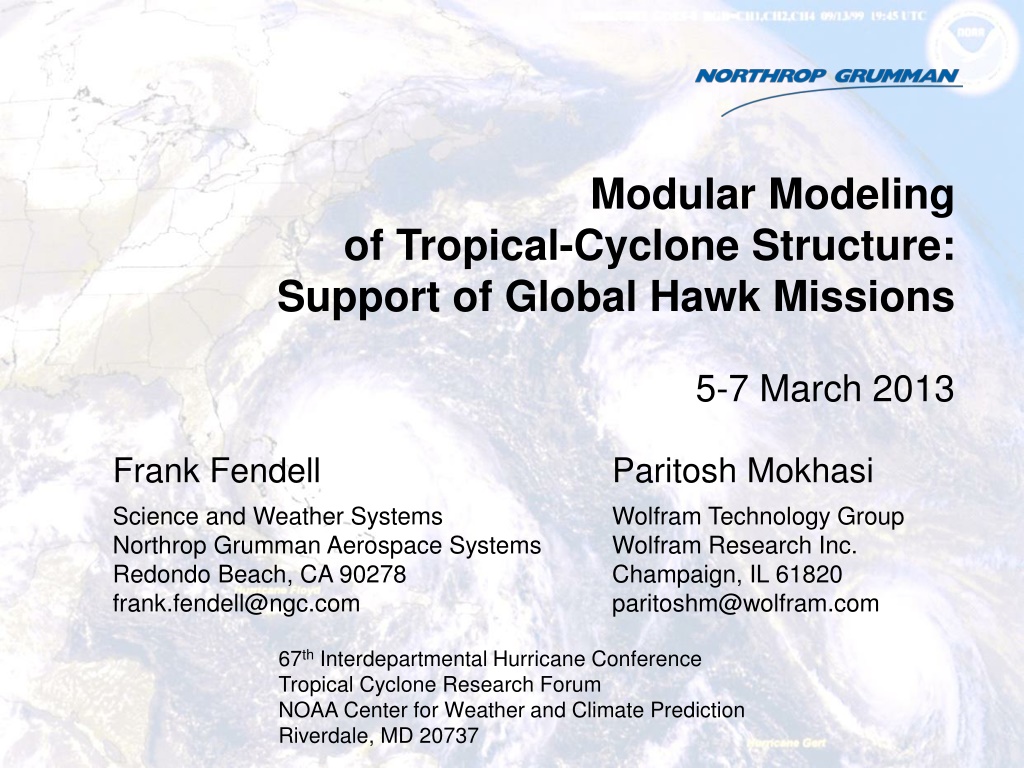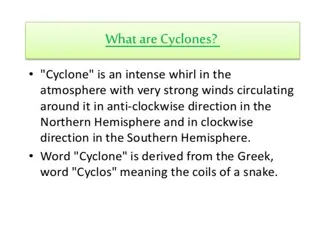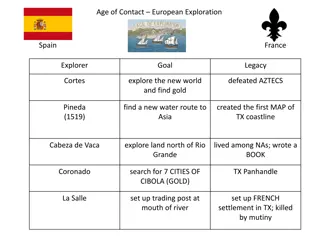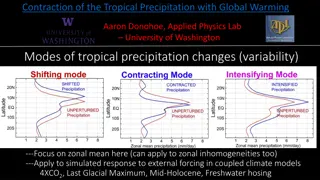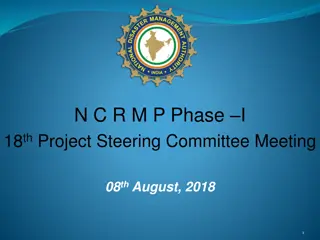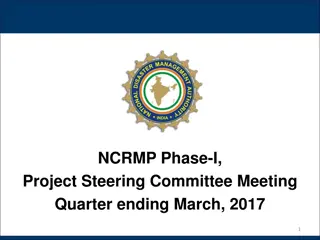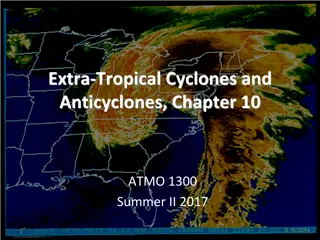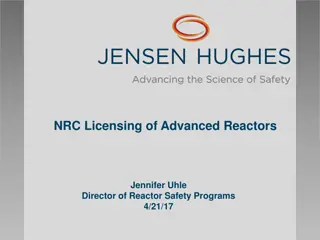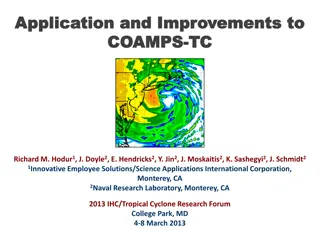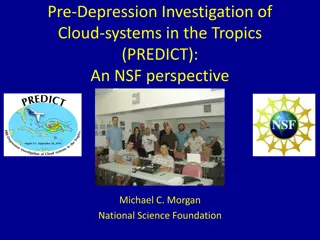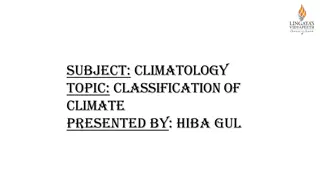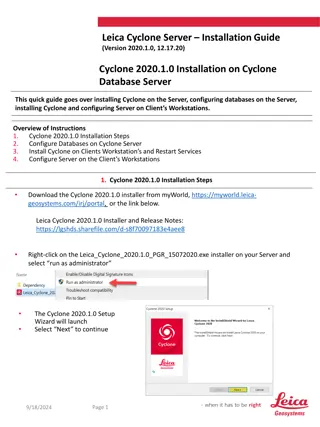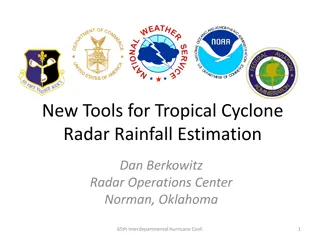Modular Modeling of Tropical Cyclone Structure: Supporting Global Hawk Missions
This text discusses the challenges in forecasting tropical cyclone intensity and proposes an intermediate approach between detailed simulations and empirical correlations. It highlights the Global Hawk UAV's capabilities for storm tracking and data collection, emphasizing the importance of adapting methodologies for improved accuracy.
Download Presentation

Please find below an Image/Link to download the presentation.
The content on the website is provided AS IS for your information and personal use only. It may not be sold, licensed, or shared on other websites without obtaining consent from the author. Download presentation by click this link. If you encounter any issues during the download, it is possible that the publisher has removed the file from their server.
E N D
Presentation Transcript
Modular Modeling of Tropical-Cyclone Structure: Support of Global Hawk Missions 5-7 March 2013 Frank Fendell Science and Weather Systems Northrop Grumman Aerospace Systems Redondo Beach, CA 90278 frank.fendell@ngc.com Paritosh Mokhasi Wolfram Technology Group Wolfram Research Inc. Champaign, IL 61820 paritoshm@wolfram.com 67th Interdepartmental Hurricane Conference Tropical Cyclone Research Forum NOAA Center for Weather and Climate Prediction Riverdale, MD 20737
Status of Prevailing Approaches for Guiding Intensity Forecasts Focus is limited to tropical cyclones (TCs) of at least depression strength. Limited improvement in decades in forecasting the intensity of such TCs Intensity depends predominantly on thermofluid-dynamic processes internal to the vortex proper. Today, only local-area (regional) models may aspire to achieve, in real-time, adequately refined lateral resolution of the vortex core (< 1 km). Prevailing approaches to guide intensity forecasts cluster around two distinctly different paradigms: 1) Detailed, computationally intensive, numerical simulations proceeding from fundamental principles, with parameterization of subgridscale processes (figures of merit: comprehensiveness, inclusiveness); and 2) Simplistic, fast-running empirical correlations relating key output parameters to input parameters on the basis of archived records ( statistical methods ). Unsatisfactorily performing detailed simulations subsequently are tuned against the same historical data base underlying statistical methods. The two approaches may end up producing two curvefits utilizing the same data base, one elaborate curvefit and one simplistic but performing comparably (inadequately). We propose to work in the vast intermediate relatively-neglected gulf by adopting a semi-analytic/semi-numeric methodology. 2 13-46781_9/19/2024 9:19 PM
The Turbofan-jet-powered Global Hawk, a High-Altitude/Long-Endurance (HALE)-type UAV 3 13-46781_9/19/2024 9:19 PM
Towards a CONOPS for the Global Hawk The Global Hawk seems the only platform in production with power and operational flexibility to (RQ-4 parameters values cited) arrive quickly on site from anywhere (ferry range 11,000 nm; loiter speed 343 kt) carry extensive instrumentation (internal payload capacity 1500 lbs, pod capacity 700 lbs/side) hover over and track storms (max endurance 31 h; max altitude 65,000 ft) permit real-time readout of data (via satellite link) permit in-flight reprogramming of a mission (say, in response to the unanticipated). Yet, NASA HS3 program distinguishes surveillance missions to sound the ambient from over-flight missions to probe the vortex proper. It seems no more feasible for a GH to measure every field everywhere in the vortex throughout its lifespan than to compute every field everywhere in the vortex throughout its lifespan (off-line research). Should the GH s appraisal hang on whether detailed simulations are benefitted? 4 13-46781_9/19/2024 9:19 PM
Towards a CONOPS for the Global Hawk (continued) To assist operationally with the few, well-chosen, specific parameters targeted in a 6-hour-updated NHC intensity forecast, what observations have priority (a CONOPS for real-time input)? What should the GH s sensors be looking at, and what should they be looking for? What would help an operational forecaster with anticipating TS H, H MH transitions? Whereas most current GH observations of TCs serve computer modeling, should not some modeling primarily serve GH observations? A flexible, simplistic, fast-running, portable, readily transparent, easily modified model seems appropriate to select accessible observables, set sensor specs, etc. 5 13-46781_9/19/2024 9:19 PM
Subdivisional Analysis of Tropical-Cyclone Structure vis- -vis Direct Numerical Integration Boundary-layer theory is a heuristic asymptotic technique, developed intuitively by fluid dynamicists to exploit relative rates of change. This widely useful methodology, later formalized by applied mathematicians under the designations singular perturbation, matched asymptotic expansions, or multiscaling techniques, is pursued as follows: 1) Subdivide the flow domain into logical subdomains (or modules), each having distinct dominant phenomenology; 2) Solve, in logical sequence, the approximate formulations that have been customized for each subdomain by retaining just the locally dominant phenomena; and 3) Meld the locally valid solutions into a global composite by enforcing continuity of dependent-variable fields and fluxes at the interfaces (or strips of common validity) between adjacent subdomains. The very first application of boundary-layer theory, over a century ago, exploited the special characteristics of diffusive transfer in the limit of indefinitely large Reynolds number (closely related to the application of interest here). For systematic, self-consistent scaling of variables, we introduce nondimensional formulation. Adopt, for normalization, in-hand input quantities, not to-be-found output quantities. Scaling laws guide the compositing of data, whether from different vortices, or from the same vortex at different times during its lifespan. 6 13-46781_9/19/2024 9:19 PM
Subdivisional Analysis of Tropical-Cyclone Structure vis- -vis Direct Numerical Integration (continued) Note the expected efficiency and simplicity relative to finite-differencing, which retains, everywhere in the flow domain and at all times, any term important anywhere in the flow domain at any time. The requirements for computer-processing power for numerical simulation are ballooning because phenomenologies, once regarded as of lesser importance, are continually being incorporated (e.g., underlying-ocean coupling), in response to flawed forecasts, while nothing is discarded for compensation, even if an addition proves to have limited or inconsequential impact. Thus, resolving, in real time, the vortex core remains elusive to detailed simulation, even as computer-processing power is continually and significantly enhanced; detailed models are growing at least as rapidly as computer-processing power. Note further that the subdivisional approach is asymptotic, and applies more appropriately in more extreme scenarios. Whereas numerics is most challenged as a TS cat 5 (e.g., Wilma), the subdivisional approach becomes more accurate in more intense scenarios. Accordingly, the subdivisional approach suggests initial focus on an intense vortex, then undertaking analysis of its less fully developed antecedents just the reverse sequence of boundary/initial-value-problem numerics. 7 13-46781_9/19/2024 9:19 PM
Schematic of the Incipient Insertion of an Eye with Relatively Dry, Nonrotating, Upper-Tropospheric Air z1 z IV I III II 0 R r rO G.F. Carrier J. Fluid Mech.49, 149 (1971) 8 13-46781_9/19/2024 9:19 PM
Schematic of a Mature Intense Hurricane, with Rough Dimensions (Not Drawn to Scale) z1 IV III O(9 km) Pressure, p Altitude, z I O(3 km) O(1 km) II 0 re ro O(10 km) Distance from Center, r O(20 km) O(500 km) Based on: G.F. Carrier J. Fluid Mech.47, 147 (1971) 9 13-46781_9/19/2024 9:19 PM
The Dynamics of the Tropical-Cyclone Boundary Layer For steady axisymmetric flow of an incompressible fluid with a constant kinematic viscosity (ascribed eddy-diffusivity values), nondimensionalize as follows (Ekman number E 1): ( ) r o o , p p = = q q = = r , , E , o o where o is a reference angular momentum per mass , is the Coriolis frequency, and p p~ + = ) ( r v + = 2 or 2 + = , z g . z r g , ( q ) 2 gz , e e= e Dropping the primes, dimensionless equations for continuity and conservation of momentum take the form 2 ) 0, ( 2 ( q = + q q + q = q q z ) 2 ( ). p E In axisymmetric cylindrical polar coordinates, r u = + + = . z z + r r q r , z w v In the (nondiffusive) bulk vortex, as z top of the boundary layer, p ), r ( W w ( ) ( ) 1 , o r rV r r rv = + (gradient r V V r 2 + = / r ( , ) (generalized potential vortex), v r ( V ), 2 o o 2 wind balance). 10 13-46781_9/19/2024 9:19 PM
The Dynamics of the Tropical-Cyclone Boundary Layer (continued) In the frictional layer, introduce = z/ that the boundary layer is of uniform thickness across values of r, and adopt the expansions (n.b. the relatively small vertical velocity component): ( ) ..., , r u u b + = ( ) ..., , r w E w b + = p , r p p b b , which implies E ( , r ( ) ..., + ) = = v v b ( ). r = ( ) r If we define w~ ~ = = = = = = 2 2 2 rv , rV , ru , w x , r , , b b b then, upon dropping tildes, the conservation laws become ( w x + + ) = = = 0 0 0 w (continuity), (conservation of radial momentum), (conservation of angular momentum). ) x x ( w 2 2 2 + + 2 + x The boundary and starting conditions for the parabolic problem are: ( ) x , + 1 0 : 0; 0 0 : 0 = = = , w , ( ) x x ] ( ) [ ] [ 2 cos 1 ( ) x / w x { [ ] [ sin 1 2 1 (potential x vortex) [ = = = : 1 sin 2 exp exp 2 , Ekman solution ], 2 x } ][ ] + 2 cos 2 exp 2 . We seek ( , x ) ( ) x ( ) x = 1 2 for 1 w W x . x 11 13-46781_9/19/2024 9:19 PM
Schematic of the Boundary-Layer Flow for a Noninertial-Frame Potential Vortex above a Nearly Immobile, Nearly Planar Surface z1 III IV Altitude, z Pressure, p I (r) II 0 re Distance from center, r ro (r) Nonlinear boundary layer under large swirl: 0 < (r) << (r) (r) zb (r) thick outer sublayer u2 (r,zb ) + v2 (r,zb ) = V 2(r) 0 zb (r) thin inner sublayer 0 u(r,zb ) V(r), v(r,zb ) 0; As r decreases, (r) increases modestly, (r) decreases. Linear boundary layer under small swirl (Ekman layer): 0 u(r,zb ) V(r)/3 0 v(r,zb ) V(r) u(r,zb ) boundary-layer inflow v(r,zb ) boundary-layer swirl V(r) bulk-vortex swirl In the boundary layer, friction contributes to the radial-momentum balance. 12 13-46781_9/19/2024 9:19 PM
Mean Vertical Velocity vs. Cylindrical Radius, near the Top of the Frictional Layer under a Vortical Storm w 0 r G.F. Carrier J. Fluid Mech.49, 156 (1971) 13 13-46781_9/19/2024 9:19 PM
Dimensionless Downdraft W(x;) at the Top Edge of the Boundary Layer x 0.0 0.2 0.4 0.6 0.8 1.0 0.0 0.5 1.0 1.5 W(x; ) 2.0 2.5 3.0 3.5 14 13-46781_9/19/2024 9:19 PM
Dimensionless Streamfunction (x,edge) at the Top Edge of the Boundary Layer 1.5 1.0 (x, edge) 0.5 0.0 0.0 0.2 0.4 0.6 0.8 1.0 x 15 13-46781_9/19/2024 9:19 PM
Profiles of the Axial Velocity w(x,) at Ten Streamwise Stations 0 w(x, ) 1 2 8 6 4 2 0 0.0 0.5 x 1.0 16 13-46781_9/19/2024 9:19 PM
Profiles of the Radial Influx (x,) at Nine Streamwise Stations 8 6 4 2 0.0 0.0 0.2 0.5 x (x, ) 0.4 1.0 0.6 17 13-46781_9/19/2024 9:19 PM
Isopleths of the Radial Influx (x,) in the Boundary Layer 4 0.1 3 08 2 0.3 0.1 1 0.2 0.7 0.4 0.85 0.6 0.0 0 0.2 0.4 x 0.6 0.8 18 13-46781_9/19/2024 9:19 PM
Ten Profiles of the Friction Term in the Radial-momentum Equation 8 6 4 2 0 0.05 50 0.10 0.15 x 100 0.20 19 13-46781_9/19/2024 9:19 PM
Profiles of the Relative Angular Momentum (x,) at Ten Streamwise Stations 1.0 (x, ) 0.5 0.0 8 6 4 2 0 0.0 0.5 x 1.0 20 13-46781_9/19/2024 9:19 PM
Ten Profiles of the Friction Term in the Swirl-momentum Equation 0.05 x 0.10 0.15 0.20 8 6 4 2 0.0 0.5 1.0 21 13-46781_9/19/2024 9:19 PM
Normalized Streamlines (x,) {darker contours}; Isopleths of Angular Momentum (x, ) {lighter contours} 0.9 0.8 0.7 0.6 0.5 0.4 0.3 0.2 0.1 8 1.2 0.3 0.5 0.8 1.3 6 0.9 0.4 1.1 0.6 4 0.7 0.2 0.1 2 0 0.2 0.4 0.6 0.8 1.0 x 22 13-46781_9/19/2024 9:19 PM
The Energetics of the Tropical-Cyclone Boundary Layer Adoption of the incompressibility approximation decouples the analyses of the boundary-layer dynamics and energetics. The components of the in-hand wind field enter as known variable coefficients in the advective terms of the conservation laws for the energetics (conservation of water vapor Y and total stagnation energy E). Explicitly, under equidiffusion, the boundary-value problems for Y and E( cpT+ LY + gz + q2/2) are: ) ( E , x x + ) ( Y , x x + = = ( ( , x , ) ) , w w x E Y E Y , subject to the starting and boundary conditions: ( : x Y Y edge : 0 sea E Y Y , = (1) : 1 edge Y Y x = (1) edge E E E Y [ sea E , [ + + ) ( ); E E ; Y x edge sea erfc ] ] erfc (1) (1) ; . edge E sea edge In this formulation, the boundary-value problems for Y(x, ) and E(x, ) are decoupled; more generally, the sea-surface temperature is not isothermal for all x, Ysea is linked to Esea , and the problems are coupled. Observationally, the tropical-cyclone boundary layer remains predominantly unsaturated for all x and . 23 13-46781_9/19/2024 9:19 PM
A Steady Axisymmetric Inviscid Model of the Bulk Vortex We follow the generalization by Baum (2005) of the treatment by Batchelor [An Introduction to Fluid Dynamics (1967), sec. 7.5]. Continuity (conservation of mass) is satisfied by introduction of a streamfunction (r,z): = = , . wr ur r z Conservation of angular momentum admits an integral: r rv = + o 2 ( ) classical a for potential vortex. The generalized Bernoulli equation admits an integral: 2 + + + = ( 2 ) cp T LY gz q E . Conservation of water vapor admits an integral, because of the absence of net phase change: Y = ( ). Y Parenthetically, in the core, net phase change occurs at saturation (denoted by subscript s), so Y entails the empirically saturation vapor pressure, ps(T) ( , ) s ( ) p p T = s , 0 622. . Y Y T p 24 13-46781_9/19/2024 9:19 PM
A Steady Axisymmetric Inviscid Model of the Bulk Vortex (continued) Conservation of energy admits an integral (the dry adiabat): cplog(T/Tr ) Ralog(p/pr) = S( ). Parenthetically, a generalized integral (the moist adiabat) holding in the saturated core is given by cplog(T/Tr ) Ralog(p/pr)+ LYs /T = Ss( ). The equation of state is approximated to be that of dry air: p = RaT. Conservation of radial momentum, upon substitution of the foregoing integrals, with q2 v2, yields a semi-linear second-order elliptical partial differential equation: 1 1 r r z z r r ( ) ( ) ( ) ( ) ( ) . + = TS + r E LY v r What amount of fluid may enter the vortex is constrained by the amount of ingestion into the surface boundary layer that is compatible with the absolute angular momentum specified for the influx at the periphery. 25 13-46781_9/19/2024 9:19 PM
A Steady Axisymmetric Inviscid Model of the Bulk Vortex (continued) The position of, and properties along, the interface (a streamsurface) between the bulk vortex and the core are identified by enforcing continuity of pressure across the interface. The interface is a vortex sheet and contact surface, but not an isobar. At the periphery, the altitude of the interface separates the domain of influx to the vortex from the domain of efflux from the vortex; at the top edge of the boundary layer, the radius of the interface separates the domain of entrainment to the boundary layer from the domain of detrainment from the boundary layer. The flow in the saturated core is also steady, axisymmetric and inviscid; but the throughput detrained from the diffusive boundary layer is described by integrals Es( ), Ss( ), s ( )which differ from the integrals E( ), S( ), ( ) holding in the bulk vortex. 26 13-46781_9/19/2024 9:19 PM
Reprise of Modular Modeling of the Tropical-Cyclone Structure A logical sequence for addressing the modules comprising the structure of a cyclone would be in the order that they are traversed by the throughput. However, the crucial role of a boundary layer in swirling flow gives the boundary layer analytic priority The angular momentum of intake at the periphery is plausibly regarded as invariant with altitude. Since angular momentum is variant along streamlines in the inviscid bulk vortex, the angular momentum at the top edge of the boundary layer is radially invariant. So, as a first step, the entrainment profile at the top edge of the boundary layer may be inferred from the dynamics for an incompressible boundary layer. Then, the radial profiles of Y and E at the top edge of the boundary layer may be inferred from the vertical stratification of Y and Ein intake at the periphery. Hence, the solution for the bulk-vortex module is nonessential. However, the position of, and properties along, the interface between the bulk-vortex/core-flow modules need to be identified for solution of the core-flow module. 27 13-46781_9/19/2024 9:19 PM
References Baum, H. and F. Fendell (2006). HIRWG (Hurricane Intensity Research Working Group) minority report, 25 pp., https://www.sab.noaa.gov/Reports/HIRWG_finalMinority.pdf Carrier, G.F., A.C. Hammond, and O.D. George (1971). A model of a mature hurricane. Journal of Fluid Mechanics 47, 145-170. Carrier, G.F. (1971a). Swirling flow boundary layers. Journal of Fluid Mechanics49, 133-144. Carrier, G.F. (1971b). The intensification of hurricanes. Journal of Fluid Mechanics49, 145-158. Carrier, G.F., F. Fendell, J. Mitchell, and M. Bronstein (1994). Self-sustaining intense vortices. Physica D77, 77-96. Dergarabedian, P. and F. Fendell (1977). One-and-two-cell structure in tornadoes. Proceedings of the Symposium on Tornadoes Assessment of Knowledge and Implications for Man, (R.E. Peterson, ed.), Institute for Disaster Research, Texas Tech U., Lubbock, pp. 501-521. Fendell, F. (1974). Tropical cyclones. Advances in Geophysics, Vol. 17, (H.E. Landsberg and J. Van Mieghem, eds.), Academic, NY, pp. 1-100. 28 13-46781_9/19/2024 9:19 PM
